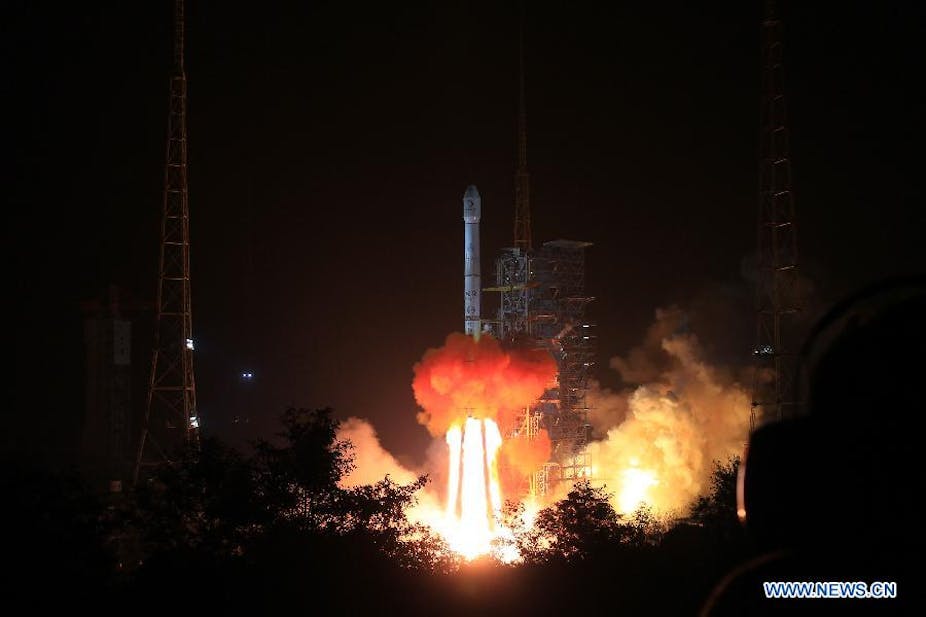Earlier this week China launched one of its venerable Long March rockets. That event in itself is no longer news as China has become one of the world’s busiest and most reliable providers of satellite launch services. This particular rocket, however, will deliver the Chinese rover Chang’e-3 to the surface of the moon.
Dubbed Jade Rabbit, the golf cart-size rover will spend three months exploring the lunar surface, gathering and analysing soil, and conducting ultraviolet light experiments. While China had successfully sent orbiters around the moon in 2007 and 2010, this will be the first “soft” landing by China or any other country since the Soviet Union’s Luna 24 in 1976.
The rover represents just the tip of a long Chinese spear of space accomplishments and ambitions, which include human space flight, a space station under construction and a planned human mission to the moon within 15 years. But perhaps what is even more significant about this rover is that it symbolises an overall growth and shift in the space arena, which now an ever-greater number and variety of countries with space programmes.
Wanting the pie in the sky
Since the early days of the Cold War, space activities have been traditionally associated with the largest, wealthiest, and most powerful countries. Apollo, Viking, Soyuz and the International Space Station are among the project names that bear witness to the dominance that the United States, Russia and the European Space Agency has exercised in space. But today’s space arena is an increasingly crowded place. While these traditional space actors still have very active and viable space programmes, they must increasingly accommodate themselves to the fact that many other countries are vying for the technology, resources and space in, well, space. Among the newer players, developing countries are asserting their place in space.
Among the largest and more economically advanced countries in the developing world, three countries are the leaders in elevating their space programmes’ national importance: China, India and Brazil. Each shares a common history of investing in advanced rocketry, nuclear energy and weapons research and advancing a space programme. But these countries’ space ambitions, while longer and more complicated, are shared by a growing list of developing countries that see a space programme as an essential part of their national security and economic development.
From Indonesia to Argentina to South Africa, nations have been spending relatively large amounts of money to develop or purchase space-based assets. Argentina is investing millions in the development of its own Tronador launcher, which will be able to put smaller satellites into low-Earth orbit. Mexico has announced plans to build a space centre in its Yucatan region. Nigeria founded its space agency in 1998 and has purchased, and even helped to build, its own satellites. Indonesia has been invested in satellite communications since 1976. In all, over a dozen developing countries have official space agencies and space programmes and many others are eagerly purchasing satellites that space-faring countries will launch for them.
But why would poorer countries invest in space instead of on the ground? The answer is fairly simple: the rewards are usually greater than the investments. Technological innovations help spur economic growth and thus poverty eradication.
It is now transparent to most people that many aspects of modern life are directly and indirectly dependent upon satellites. Satellites make long-distance, multichannel television and even some long-distance telephone and Internet communications possible. Modern GPS services, weather forecasting, and disaster responses depend on satellites. Since the dawn of the space age, modern militaries have steadily expanded their use and reliance on satellite-based communications, reconnaissance, and even space-based spy capabilities, which have become the touchstone of their defensive (and offensive) capabilities.
But aside from these most impressive capabilities, satellites also provide developing countries with invaluable capabilities to grow their economies and improve the quality of their citizens’ lives. For example, rural residents in India use satellite-based communications to connect to urban centres for otherwise unattainable medical expertise. Farmers in Argentina and Vietnam use satellite-based soil, water and crop information for to carry out precision farming, which optimises returns on inputs.

Old game, new players
For the larger and wealthier developing countries, the goal of having an “eye in the sky” has become indispensable. Countries as diverse as Brazil, India, Iran, Pakistan and Kazakhstan have Earth-observation satellites to monitor the environment but can also use them as reconnaissance satellites to keep tabs on potential adversaries in the neighbourhood. China, in particular, has been hard at work launching into orbit constellations of communications, reconnaissance, and spy satellites to enhance its claim as the rising power in Asia and the world.
So space technology – like other varieties of technology – is no longer the purview of a select handful of wealthy countries. Developing countries see access to space for both its practical and symbolic values. The fact that China is heading to the moon should not really be too surprising. It demonstrates the country’s technological and economic ascension in a way that few other national acts could. Perhaps equally important is that fact that its neighbour, India, had already sent a Moon orbiter in 2008 and has another planned in the near future. Earlier this week, India launched its Mars Orbiter Mission, which is now on the way to the red planet.
In essence, China is engaged in prestige-building, technology improvement and one-upsmanship, all at the same time. But that has been the story since the dawn of the space age. It’s just that today, other countries have entered the fray.

